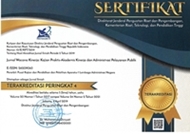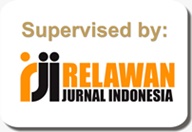Comparative Study Management Of Training (MOT) Between Blended Learning And Fully Online Learning Methods
Abstract
The COVID 19 pandemic also has an impact on the education and training aspects of the State Civil Apparatus. MOT training in Puslatbang PKASN LAN, which was originally carried out by blended learning in 2019, has been changed to fully online learning in 2020, as an effort to reduce the spread of the COVID 19 virus. The purpose of this study is to find out whether there are differences on the learning outcomes between MOT participants in 2019, which attended by 30 people, and MOT participants in 2020, which attended by 25 people. Data processing and analysis techniques in this study using quantitative methods. The statistical test used is the non-parametric statistical test using the Mann Whitney U test. The sampling technique used was total sampling, where all members of the population were used as samples. The results revealed that there was no difference in the learning outcomes of MOT participants between those using the blended learning method and those using the fully online learning method. Based on this information, fully online learning is very possible to be applied. Nevertheless, the Training Institution must pay attention to the availability of facilities and infrastructure that support the learning process electronically. Also, the limited interaction between lecturers and participants when doing online learning should be balanced with the ability of lecturers to convey material with technology-based learning techniques. In this case, the roles of all parties will determine the optimal achievement of the fully online learning process.
Keywords
Full Text:
PDFReferences
Ade Kusmana. (2011). E Learning Dalam Pembelajaran. Lentera Pendidikan, 14(1), 35–51.
Allen, IE, Seamen, J, &. G., & R. (2007). Blending in: The extent and promise of blended education in the United States. USA: The Sloan Consortium. In Blending in: The extent and promise of blended education in the United States. USA: The Sloan Consortium. (Issue January).
Arsyad, A. (2013). Media Pembelajaran. PT Raja Grafindo Persada.
Chang, C. C., Shu, K. M., Liang, C., Tseng, J. S., & Hsu, Y. S. (2014). Is blended e-learning as measured by an achievement test and self-assessment better than traditional classroom learning for vocational high school students? International Review of Research in Open and Distance Learning, 15(2), 213–231. https://doi.org/10.19173/irrodl.v15i2.1708
Fandianta, Sanjaya, G. Y., & Widyandana. (2013). Meningkatkan Pengetahuan Mahasiswa Dengan Memberikan Fleksibilitas Belajar Melalui Metode Blended learning. Jurnal Pendidikan Kedokteran Indonesia, 2(2), 1–8.
Firman, F., & Rahayu, S. (2020). Pembelajaran Online di Tengah Pandemi Covid-19. Indonesian Journal of Educational Science (IJES), 2(2), 81–89. https://doi.org/10.31605/ijes.v2i2.659
Ghozali, I., & Ratmono, D. (2018). Analisis Multivariat dan Ekonometrika, teori, konsep dan aplikasi dengan e views 10. Badan Penerbit Universitas Diponegoro.
Hadisi, L., & Muna, W. (2015). Pengelolaan Teknologi Informasi Dalam Menciptakan Model Inovasi Pembelajaran (E-Learning ). Jurnal Al-Ta’dib, 8(1), 117–140.
Hamdi, A. S., & Baharuddin, E. (2014). Metode Penelitian Kuantitatif Aplikasi Dalam Pendidikan (A. Anas (ed.)). Deepublish.
Hidayat, A. (2013). Pengertian dan Rumus Uji Saphiro Wilk. In Statistikian.Com. https://www.statistikian.com/2013/01/saphiro-wilk.html
Hidayat, A. (2014). Penjelasan Uji Mann Whitney. https://www.statistikian.com/2014/04/mann-whitney-u-test.html
Horvitz, B. S. (2007). N. Dabbagh and B. Bannan-Ritland, Online Learning: Concepts, Strategies, and Application. Educational Technology Research and Development, 55(6), 667–669. https://doi.org/10.1007/s11423-007-9071-4
Humas LAN. (2020a). Jalan Menuju ASN Unggul Pasca Pandemi. Https://Lan.Go.Id/?P=2523.
Humas LAN. (2020b). Sinergi Kebijakan Dan Pelayanan Publik Di Era New Normal. Https://Lan.Go.Id/?P=2517.
Husamah. (2014). Pembelajaran Bauran, Blended Learning. Prestasi Pustaka Publisher.
Karwati, E. (2014). Pengaruh Pembelajaran Elektronik (E-Learning) terhadap Mutu Belajar Mahasiswa. Jurnal Penelitian Komunikasi, 17(1), 41–54. https://doi.org/10.20422/jpk.v17i1.5
Khoiroh, N., Munoto, & Anifah, L. (2017). Pengaruh Model Pembelajaran Blended Learning Dan Motivasi Belajar Terhadap Hasil Belajar Siswa. Jurnal Penelitian Ilmu Pendidikan, 10(2), 14.
LAN. (2018). Peraturan Lembaga Administrasi Negara Republik Indonesia Nomor 10 Tahun 2018 Tentang Pedoman Pengembangan Kompetensi Pegawai Negeri Sipil. 1–6.
LAN. (2019). Keputusan Kepala LAN No. 356 Tahun 2019 Tentang Pedoman Penyelenggaraan MOT. LAN.
Lestari, E., Karunia, Ridwan, M., & Yudhanegara. (2015). Penelitian Pendidikan Matematika. PT. Refika Aditama.
Maskar, S., Dewi, P. S., & Puspaningtyas, N. D. (2020). Online Learning & Blended Learning: Perbandingan Hasil Belajar Metode Daring Penuh dan Terpadu. Prisma, 9(2), 154. https://doi.org/10.35194/jp.v9i2.1070
Mawardi. (2010). Pengaruh Pelatihan terhadap Kinerja PNS. Koleksi Perpustakaan Universitas Terbuka.
Moore, J. L., Dickson-Deane, C., & Galyen, K. (2011). E-Learning, online learning, and distance learning environments: Are they the same? In Journal Internet and Higher Education 14 (pp. 129–135). University of Missouri. https://www.researchgate.net/publication/233779932_E-Learning_online_learning_and_distance_learning_environments_Are_they_the_same
Napitupulu, R. M. (2020). Dampak pandemi Covid-19 terhadap kepuasan pembelajaran jarak jauh. Jurnal Inovasi Teknologi Pendidikan, 7(1), 23–33. https://doi.org/10.21831/jitp.v7i1.32771
Rachman, A., Sukrawan, Y., & Rohendi, D. (2019). Penerapan Model Blended Learning Dalam Peningkatan Hasil Belajar Menggambar Objek 2 dDmensi. Journal of Mechanical Engineering Education, 6(2), 145–152.
Ramsay, G. (2001). Teaching and Learning with Information and Communication Technology : Succes Through a Whole School Approach. Building on the Future, 1–9. https://files.eric.ed.gov/fulltext/ED462943.pdf
Rusman. (2018). Model-model pembelajaran : mengembangkan profesionalisme guru. Rajawali Pers.
Rusman, Kurniawan, D., & Riyana, C. (2011). Pembelajaran Berbasis Teknologi Informasi dan Komunikasi. Rajawali Pers.
Siahaan, S. (2004). E-Learning (Pembelajaran Elektronik) Sebagai Salah Satu Alternatif Kegiatan Pembelajaran. Jurnal Pendidikan Dan Kebudayaan 42, UPT Perpustakaan Digital Universitas Negeri Malang.
Sugiyono. (2014). Metode Penelitian Pendidikan Pendekatan Kuantitatif Kualitatif dan R&D. Alfabeta.
Sugiyono. (2019). Metode Penelitian Kuantitatif. Alfabeta.
Sutopo, A. H. (2012). Teknologi Informasi dan Komunikasi dalam Pendidikan. Graha Ilmu.
Wardani, D. N., Toenlioe, A. J. E., & Wedi, A. (2018). Daya Tarik Pembelajaran Di Era 21 Dengan Blended Learning. Jurnal Kajian Teknologi Pendidikan (JKTP), 1(1), 13–18. https://core.ac.uk/download/pdf/287323676.pdf
Weldy, T. G. (2018). Traditional, Blended, or Online: Business Student Preferences and Experience with Different Course Formats. Journal of Business Education & Scholarship of Teaching, 12(2), 55–62.
Widodo, S. (2015). Manajemen Pengembangan Sumber Daya Manusia. Pusaka Pelajar.
Yudistira Adi Nugroho. (2020). Tantangan Widyaiswara di Era New Normal. Kkp.Go.Id.
Zhang, D., Zhao, J. L., Zhou, L., & Nunamaker, J. F. (2004). Can e-learning replace classroom learning. Https://Dl.Acm.Org/Magazine/Cacm, 47. https://doi.org/10.1145/986213.986216
DOI: http://dx.doi.org/10.31845/jwk.v24i2.697
Refbacks
- There are currently no refbacks.
Copyright (c) 2021 Yunni Susanty

This work is licensed under a Creative Commons Attribution-NonCommercial-ShareAlike 4.0 International License.
JURNAL WACANA KINERJA INDEXED BY:
__________________________________________________________________________________________________________
@2023 Center fo State Civil Apparatus Training and Development and Competency Mapping (Pusat Pelatihan dan Pengembangan dan Pemetaan Kompetensi Aparatur Sipil Negara Lembaga Administrasi Negara - Puslatbang PKASN LAN) Jl. Kiara Payung KM. 4, 7 Jatinangor, Sumedang, Jawa Barat 45366 Telp. (022) 7790048-7790044-7790049-7782041-7782042 Fax. (022) 7790055-7782178; Email: wacanakinerja@yahoo.com; wacanakinerja@gmail.com
Powered by OJS
















